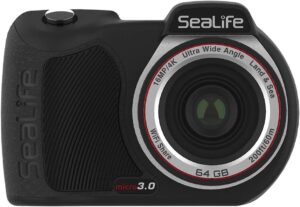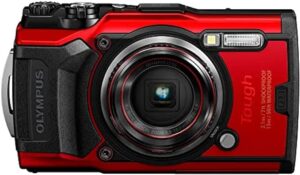No products in the cart.
Underwater Photography for New Scuba Divers

As a new scuba diver, the feeling of exploring the underwater world is truly mesmerizing. The vibrant colors, diverse marine life, and unique landscapes make it an incredible experience. What better way to capture these wonders than through underwater photography? In this guide, we will equip you with the essential knowledge to master underwater photography as a new scuba diver, helping you create stunning images that tell the story of your underwater adventures.
Understanding the Basics: Gear and Settings
Before diving into the depths with your camera, it’s important to have the right gear. There are a few good entry-level cameras that are designed for new scuba divers.
Olympus TG-6/TG-7
This is my personal favorite. If you are primarily diving in water less than 33 ft deep (1 atmosphere) you don’t even need an underwater housing, although I would still recommend you get one. The TG-6/TG-7 is a great camera because you can build on it. It’s easy to add lights, a tray, and even add a Dome to it. It has modes for both underwater macro and wide angle. It also does great video. Almost all of the photos you see on this site are shot with an Olympus TG-6/TG-7.
The TG-6/TG-7 has an app for your phone that allows you to download all the images. The app is very convenient but incredibly slow. The other option is to pop the memory card, insert it into your computer, and pull the pictures off that way.
GoPro Hero
GoPro’s are a very popular option. They produce excellent-quality pictures. For the price point, even with the addition of a tray and underwater housing, this is probably the cheapest option for getting into underwater photography.
If you decide to go with a GoPro – for the record, I’ve owned several in the past, and they are good cameras – make sure you get the underwater housing. It’s not expensive but the GoPro is “water resistant” not “waterproof at depth”.
Given their small size, I would also recommend a tray, even if you don’t add strobes. A try with handles will give you more stability than just holding it in your hand.
SeaLife Micro 3.0

SeaLife is a well-respected name in underwater photography equipment and their SeaLife Micro 3.0 is a good camera for new scuba divers. It is designed so that it is self-enclosed, meaning that it does not require additional underwater housing. While its base price is cheap, you will want to purchase one of SeaLife’s packages with a tray and at least one strobe. This will bump the price up but will make all the difference in the world for your pictures.
Getting the Right Exposure: Light is Key
In the realm of underwater photography, understanding the role of light is essential for capturing stunning images. As you venture deeper beneath the surface, natural light becomes scarce, causing colors to fade. This is where artificial lighting steps in as your ally. Introducing strobe lights or underwater flashes to your gear arsenal can work wonders. These tools provide the much-needed illumination to bring out the vibrant colors of your subjects.

Remember, the secret lies in experimenting with various angles and distances. Adjusting the placement and intensity of your artificial lights can make all the difference in achieving that perfect shot. It’s a fine balance, though. While you want to enhance the subject’s details, be cautious not to flood the scene with too much light, as it might result in overexposed and washed-out images. By mastering the art of underwater lighting, you’ll unlock a world of captivating marine photography waiting to be explored.
In all three of the lights above something like the Sea Dragon 2000F will do the trick. All 3 cameras listed above can be able to be mounted to it. The handle and tray will also increase your stability.
Composition: Posing Your Subjects
In the world of underwater photography, just like any other form of photography, composition holds the key to creating engaging and memorable images. An invaluable technique to master is the rule of thirds. This rule involves mentally dividing your frame into nine equal sections using two horizontal and two vertical lines. By placing your essential subjects along these lines or at their intersections, you introduce a sense of harmony and dynamism to your photographs.
The underwater realm offers an endless canvas for applying the rule of thirds. Whether it’s a vibrant coral reef or a graceful marine creature, strategically positioning them within these compositional lines can instantly elevate your image’s visual appeal. Don’t hesitate to experiment with various angles and perspectives. Sometimes a slight tilt or shift in viewpoint can lead to a shot that captures the essence of the underwater world in a way you hadn’t even imagined.
As you embark on your journey into underwater photography, remember that the rule of thirds is a foundation you can build upon. By understanding and applying this principle, you’ll gradually develop an intuitive sense of how to create striking compositions that truly bring mesmerizing underwater landscapes to life.
Patience and Timing: Wait for the Perfect Shot
Underwater photography is a realm where patience and impeccable timing reign supreme. Comparable to the art of wildlife photography, mastering the skill requires a keen sense of observation and the ability to seize the perfect instant to immortalize your subject. As you navigate the underwater world, be prepared to wait for that magical moment when your subject showcases its most captivating features.
Just like a seasoned wildlife photographer awaits the perfect posture of a creature, you’ll find yourself watching the behavior of marine life with a keen eye. Study their movements, understand their patterns, and predict their actions. Whether it’s a curious fish darting through a coral crevice or a majestic sea turtle gliding gracefully by, the more attuned you become to the underwater rhythms, the better your chances of capturing those awe-inspiring moments.
Remember that underwater photography is a journey of continuous learning. While your first attempts may not yield the results you desire, each dive and every click of the shutter will contribute to your growth. Patience and practice will enhance your ability to anticipate those split-second instances that translate into remarkable photographs. With each dive, you’ll gain more insights into the underwater world, refining your timing and honing your knack for encapsulating its beauty in your images.
Post-Processing: Enhancing Your Images
Once you’ve emerged from the underwater realm and returned to solid ground, the journey to perfecting your underwater images continues with the art of post-processing. This phase allows you to amplify the allure of your underwater shots through software such as Adobe Lightroom or Photoshop. These tools become your digital darkroom, enabling you to fine-tune various elements like colors, contrast, and exposure, thus elevating your captures to their full potential.
As you delve into post-processing, remember that the essence of your underwater photographs lies in their authenticity. While editing can be a creative process that allows you to accentuate certain aspects, it’s crucial to maintain the natural essence of the underwater scenes you’ve encountered. Strive to strike a balance between enhancement and realism. Adjustments should enhance the inherent beauty of the underwater world rather than transform it into something unrecognizable.
Consider your post-processing work as a delicate brushstroke that brings out the intricate details that might have been dulled by the water’s depth. Subtle adjustments can help sharpen the contours of marine life, enrich the vibrant hues of corals, and accentuate the interplay between light and shadow. Embrace the notion that post-processing is not about altering the truth but rather about revealing the hidden nuances that your lens captured beneath the surface.
The Journey of a New Scuba Diver and Photographer
Setting sail on the voyage of underwater photography as a fresh-faced scuba diver might initially appear as a daunting venture, yet with dedication, patience, and the adoption of fundamental techniques, you’re poised to unveil a captivating gallery that encapsulates the enchantment of the submerged realm. Embrace the learning curve as you gradually master the art of capturing moments beneath the waves. Each dive holds the potential to unveil a world brimming with intricate details and captivating scenes that are waiting for your lens to translate into visual stories.
While you’re maneuvering through the labyrinth of settings, lighting, and composition, always keep in mind the significance of responsible underwater photography. Your lens is not only a portal to creativity but also a means to contribute to marine conservation efforts. Treat the aquatic realm and its inhabitants with utmost respect, ensuring that your presence causes minimal disturbance. Adhere to ethical guidelines that protect the delicate ecosystems and the creatures that call them home.
As you delve into the captivating world of underwater photography, remember that your lens holds the power to transport others to the depths you’ve explored. With each click of the shutter, you’re sharing the wonders of the underwater world, encouraging empathy, understanding, and advocacy for its preservation. Embrace this journey as a steward of the oceans, wielding your camera as a tool for change and appreciation.
Wrap Up
So, are you ready to dive into the world of underwater photography? It doesn’t matter if you are diving your favorite lake, off your favorite dive boat, or a shore dive like the beautiful Blue Heron Bridge, grab your scuba gear, bring your camera, and unlock the hidden world beneath the waves!

Join Our Mailing List For New Scuba Divers
If you like this tip for new scuba divers, join our mailing list. You’ll get a new tip delivered to your inbox each week. Learn to dive confidently!

